- Home
- Resurrection ▾
-
Learn ▾
- Free library
- Glossary
- Documents
- Initiation
-
Shaped fabrics
- Introduction
- Popularization
- Definitions
- Le métier de façonné
- Principes du façonné
- Mécaniques de façonné
- Le jeu des crochets
- Les cartons
- Chaîne des cartons
- Mécanique 104 en détail
- Pour en finir
- Montage façonné
- Empoutage 1/3
- Empoutage 2/3
- Empoutage 3/3
- Punching, hanging and dip
- Autres façonnés
- Façonnés et Islam
-
Cours de tissage 1912
- Bâti d'un métier
- Le rouleau arrière
- Les bascules
- Formation du pas
- Position de organes
- Mécanique 104 Jacquard
- Fonctionnement 104
- Lisage des cartons
- Le battant du métier
- Le régulateur
- Réduction et régulateur
- Mise au métier d'une chaîne
- Mise en route du métier
- Navettes à soie
- Battage
- Ourdissage mécanique
- Préparation chaînes et trames
- Equipment ▾
- Chronicles ▾
- Fabrics ▾
- Techniques ▾
- Culture ▾
- Language ▾
©Photo Ph.Demoule
Georges Mattelon dévoilant ses secrets à
Claire Demoule de l'Atelier du Caméléon
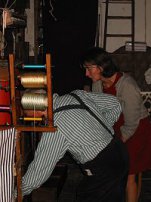
©Photo Ph.Demoule
Atelier Georges Mattelon
Métier de caméléon
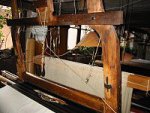
©Photo Ph.Demoule
Atelier Georges Mattelon
©Photo Ph.Demoule
Taffetas caméléon tissé par Claire Demoule
©Photo Ph.Demoule
©Photo Ph.Demoule
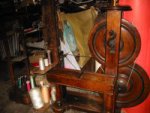
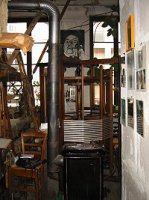

In the afternoon, Boule d'Amour, an old companion weaving on the neighboring profession of Georges Mattelon, ignored him and did not poke a word, nor did the other weavers ...
In the evening, Georges Mattelon, who was looking for a workshop for himself, went to Father Tribollet's, a science well that knew the whole history of the Croix Rousse and the weavers (the family of Maîtres-tisseurs since Louis XIV) and told him his misadventure.
When Louis XI wished to install the silk industry at Lyons, the Lyons did not want it, and this industry was therefore installed at Tours. When Francis I came to power, and came to stay several months at Lyons in 1535, he in turn wished to set up the trades at Lyons. The Florentine Turquet proposing to set up trades in Lyons, the King took an edict, exempting all those who woven in Lyons, and giving a premium of 500 livres to the Italian weavers who would come to settle in that city.After a few years, for the sake of organization, the Manufacture of Silk Workers was created. To supervise all this, were appointed masters-guards, chosen from among the wealthiest of this corporation. To distinguish them, they were given, as insignia, a cane with a straight knob, like the nobility, adorned with charms representing their trade. At the Revolution they lost their privileges or fled abroad.
Bonaparte re-established all this, but the masters-guards no longer represented much.On the death of a member of a neighboring corporation, all the corporations met at Place des Terreaux to accompany the deceased to his last abode, and the four masters-guards came down with their cane. But the cane was devoid of the silver charms which the private guards deprived of their privileges had to sell with their possessions. Someone would have shouted: "Here, here are the naked canes ...".The naked canes representing then misery and decay, this became a quip, almost an insult.
At the end of the war, the scarcity of thread led Georges Mattelon to weave a little of everything with what he could find ...
After the war, in his studio, Mr. Mattelon, like his colleagues, worked like this:The heads of department of the manufacturers came to see him in the workshop, proposing to him to weave a certain measure of fabric on their account and giving him the characteristics necessary to the weaving. Once the price per meter accepted, they supplied the warp and weft. It was then incumbent on him to mount the loom, to put it in motion, and to weave 10 cm of sample (the drawer). The time spent setting up and adjusting the craft was at the charge of the canut (weaver Lyon).
When he weaved the stuff of the dress for the future Queen Elizabeth, for the Coudurier House Fructus and Descher, it was a Duchess satin. The canut worked so well for the manufacturers, and generally were not made aware of the identity of the final customer. We ourselves, who worked in the 1980s for Maison Tassinari & Chatel, knew very rarely what our tissues were going to become. Very rarely did our manufacturer give us the information, as for this 100 meter cut of iron velvet we wove to cover the inside of a boat belonging to the royal family of England.
The Duke of Windsor, Picasso, Brigitte Bardot, Louis XIV, were the "clients" of Georges Mattelon.
After the war, there was a period of euphoria with a lot of work, during the years 1945, 1950, 1955, then the work decreased quickly because it was the moment when all the countries like Algeria, Morocco, Tunisia , Lebanon, Syria, came to buy material in France. Thousands of mechanical trades then left in these countries, braced by the artisans Lyon who could no longer survive in France with this activity. In a few years, 3/4 of the cross-Roussian trades have disappeared.
Monsieur Mattelon was for a long time the last to weave the famous taffeta chameleon, for Haute-Couture. It was he who made us discover and confided his secrets to us ...
Mr Mattelon analyzes the modern silk industry with indulgence. He explains that the looms turn at 800 or 900 strokes per minute, and that we make beautiful fabrics, but we have modified the number of warp threads to cm, we forced on the weft while in The weather was the opposite and the fabrics were stronger.In time the modes and therefore the tissues had a much longer life. So a white dress was later turned into sky blue, then brown and finally black and had thus four lives ... It was another era and the fabrics being of better quality were infinitely more solid and durable.
The greatest pleasure of Mr. Mattelon was to weave fine fabrics where there was color, gold threads. But at the end of the day, with experience and hindsight, he explains that fabrics in weaving are "nothing at all, it is a fun to do", whereas a plain fabric, It is really a complex job that is hard to achieve, that few do, because one must have patience, one must think and be much more vigilant and careful, these tissues being like a mirror that can not hide any defect.
Philippe Demoule
Sources: Our private interviews with him and...
Memory of the Century, Emission de France-Culture: Georges Mattelon, master weaver, proposed by Thierry Aveline, first broadcast on 21 August 1997.
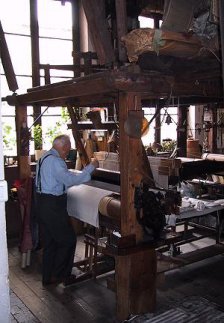
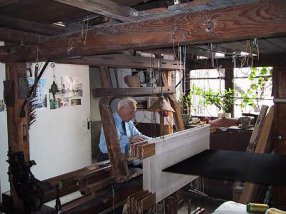
Before telling you the story of his life, I must tell you that Mr Mattelon helped us at our own start in 1979, providing us with advice and providing us with some of the material we still lacked.
©Photo Ph.Demoule
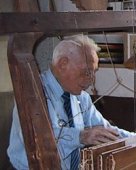
April 2004: Mr. Mattelon has just left us at the age of 91 years.
Mr. Mattelon, famous Croix-Roussienne figure (Croix-Rousse is a district of Lyon, a hill overlooking the city and where the canuts, weavers with silk arms) was born in 1913. It will therefore celebrate its 90 Years this year. According to a Swiss website that deals with the ethymology of family names, Matalon and Mattelon are popular forms that originate in the Latin word "maturus", which means "mature". Georges Mattelon thus marvelously carries his name. Not because of his age, but by the maturity he has acquired in his art over the years that he has exercised and continues to do so. For thirty years after the retirement age, one can see Mr. Mattelon busy in his workshop of weaving with arms of silks, in Croix-Rousse. He still owns 4 trades of the 19th century, classified as Historic Monuments.
Originally from Haute-Savoie, Georges Mattelon, son of a farmer in a border region with Switzerland, is found in Lyon after his mother, widow of her husband killed in the war of 14, remarries in 1919 with a weaver originating in the Loire.When he was apprenticed, around 1930, the Croix-Rousse lived to the rhythm of the bistanclac, a word born from the noise of the loom. There were still hundreds of workshops that made live and work a large number of Lyonnais.On the top floor of 10 Rue Richan, at La Croix-Rousse, there is Mr Mattelon's workshop, which used to have 9 looms, and still has four.
Living a childhood in Switzerland until 1922, returning to Lyon in 1927, where his parents bought a house to settle, they found a workshop on the fourth floor of a house in the Rue du Bon Pasteur.
In the 1920s, the Croix-Rousse is still a real village, and Georges Mattelon teenager discovers this village. The Ascent of the Great Coast was then a very frequented axis to join the center of Lyon. In particular, we saw the weavers laden with their pieces of cloth, which they went to deliver to the manufacturers who had entrusted them with this work.
His father-in-law wove church ornaments of gold, silver and silk threads on a complex weaving loom, with a creel comparable to that of the velvet looms. This fabric was then very popular in Spain and relatively well paid to the weaver. It represented a Louis XV basket, all in gold and silver, with bunches of grapes and vine leaves. All the center of the fabric was silver and had lily flowers. "That's why I'm a bit royalist," jokes Georges Mattelon who wove this fabric for quite a while. Then came the Spanish revolution, harmful to the weavers; The orders disappeared and something else had to be done.
The taffetatiers wove silk taffeta, simple and poorly paid work, but they always had work. For the little novelty, it was necessary to have a somewhat more important material, then the weavers of furnishing which had to invest in a more consistent material, with two mechanics by trade and expensive assemblies. At the top of the pyramid were the velvets who made velvet all their lives because this long work and the long and expensive preparation of the trades did not allow to change often article to be manufactured.
The population who worked for the silk was numerous to circulate in the street. They were crossed with their large blue bag containing their pugs and their silk packets, the guimiers with their very heavy bags on their shoulders, containing their gold and silver threads, the weavers with their empty or full rollers, The cartonniers carrying on their shoulders piles of cardboard on a piece of flat wood with straps, clinging when the wind began to blow, so much so that the mayor of the time, Edouard Herriot, had rests installed so that They can make stops.
In the 1920s and 1930s, work in the workshop began in the morning at 7 am until noon at quarter past lunch hour, then work resumed until 7 pm, from Monday to Saturday afternoon.
His apprenticeship in Lyon was three years, sponsored by a weaver who came to see him every week to answer questions and give advice.In those years, the weavers were rather enclosed, not so fond of seeing young people take an interest in the trade, or more exactly expecting them to show their passion for this trade. Avares of advice, eager to keep jealously for them their tricks of trade that were transmitted from father to son.
At the age of 23, Georges Mattelon returned from the regiment and had to work as a companion in a workshop in the rue de Sèvres, where two workshops were located on the fourth floor, each with 6 trades. Father Paul, the oldest, was 78 years old. One of the workshops, situated to the north, was colder, and all the weavers, who brought their food, found themselves at noon in the coldest workshop, to the south.On a fine weather day, a little windy, in February 1926, Georges Mattelon returned to the workshop by launching a "Bonjour les canuts". Father Paul, standing up and pointing at him, said to him: "Would you flay the jaws of saying" Hello, the weavers? ".
©Photo Ph. DemouleAtelier de Georges Mattelon